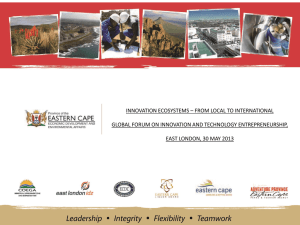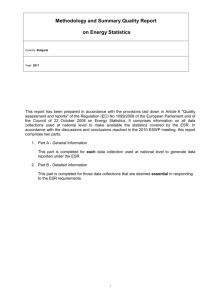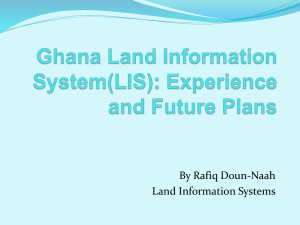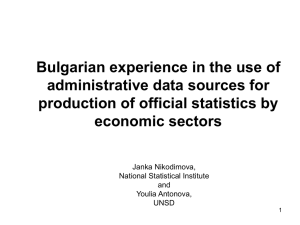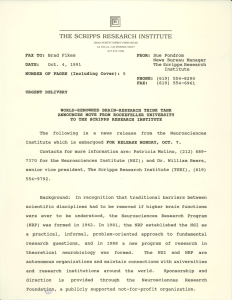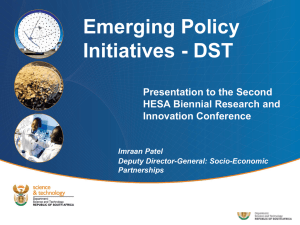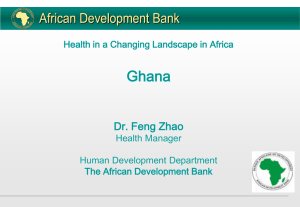National Systems of Innovation (NSI)
advertisement
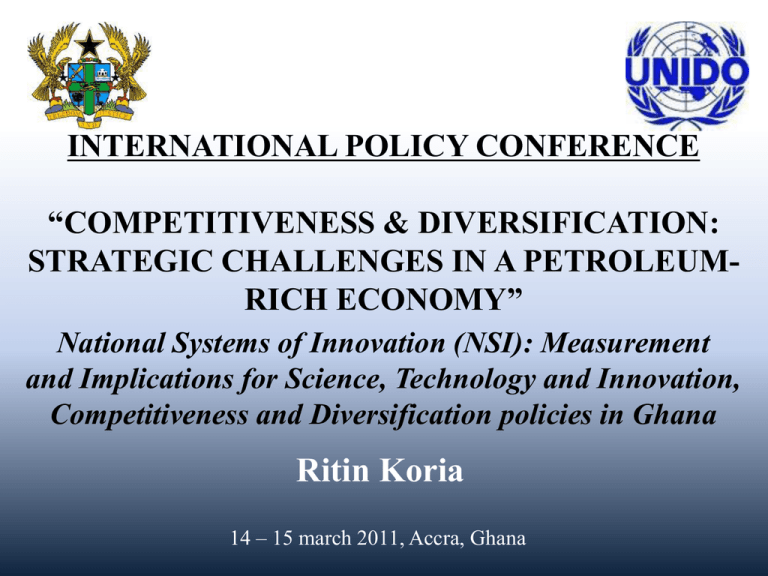
INTERNATIONAL POLICY CONFERENCE “COMPETITIVENESS & DIVERSIFICATION: STRATEGIC CHALLENGES IN A PETROLEUMRICH ECONOMY” National Systems of Innovation (NSI): Measurement and Implications for Science, Technology and Innovation, Competitiveness and Diversification policies in Ghana Ritin Koria 14 – 15 march 2011, Accra, Ghana National Systems of Innovation (NSI): Measurement and Implications for Science, Technology and Innovation, Competitiveness and Diversification policies in Ghana Ritin Koria* & Sabine Köszegi** Overview • • • • • • Definitions of NSI Graphical representation of NSI Ghana context – why measure NSI Triple Helix model types and transition Advancement of the Coherency of model Proposed methodology for measurement of NSI • Expected outputs • Conclusions Definitions of NSI (i) • · ‘ ..the network of institutions in the public and private sectors whose activities and interactions initiate, import, modify and diffuse new technologies.’ (Freeman, 1987) • · ‘ ..the elements and relationships which interact in the production, diffusion and use of new, and economically useful knowledge ... and are either located within or rooted inside the borders of a nation state.’ (Lundvall, 1992) • · ‘...a set of institutions whose interactions determine the innovative performance ... of national firms.’ (Nelson & Rosenberg., 1993) • . ‘...the set of set of institutions and economic structures affecting the rate and direction of technological change in the society.’ (Edquist and Lundval, 1993) • . ‘...the system of interacting private and public firms (either large or small), universities, and government agencies aiming at the production of science and technology within national boarders. Interaction among these actors may be technical, commercial, legal, social and financial, in as much of the goal of the interaction is the development, protection, financing or regulation of new science and technology.’ (Niosi et al, 1993) Definitions of NSI (ii) • · ‘ ..the national institutions, their incentive structures and their competencies, that determine the rate and direction of technological learning (or the volume and composition of change generating activities) in a country.’ (Patel and Pavitt, 1994) • · ‘..that set of distinct institutions which jointly and individually contribute to the development and diffusion of new technologies and which provides the framework within which governments form and implement policies to influence the innovation process. As such it is a system of interconnected institutions to create, store and transfer the knowledge, skills and artefacts which define new technologies.’ (Metcalfe, 1995) • ‘The National Systems of Innovation approach stresses that the flows of technology and information among people, enterprises and institutions are key to the innovative process. Innovation and technology development are the result of a complex set of relationships among actors in the system, which includes enterprises, universities and government research institutes’ (OECD, 1997). • ‘The envelope of conforming policies as well as private and public institutional relations, and their coherent social and capital formations, that determine the vector of technological change, learning and application in the national economy’ (Bartels, Voss, Bachtrog and Lederer, 2008). Graphical Representation of NSI REGIONAL PUBLIC LABS PUBLIC SECTOR S&T USERS UNIVERSITY LABS REGIONAL GOVERNMENT REST OF WORLD INCLUDING MULTINATIONALS NATIONAL GOVERNMENT NATIONAL PUBLIC LABS PRIVATE SECTOR LABS PRIVATE SECTOR GOODS & SERVICES PRODUCERS Flow of knowledge FINANCIAL INSTITUTIONS Flow of Financing Ghana Context – Why measure NSI • Ghana wishes to raise its country status to that of an Emerging Market Economy (EME) by 2020 • EMEs belong to an investment class of their own and don’t appear to nave a policy process for innovation. • Ghana recognises that it has, at best, very poorly configured and inefficient mechanisms — and at worst, no viable means for analysing, crafting, implementing and monitoring Science, Technology and Innovation in Ghana’s Industrial Policy. • The project addresses pragmatically the lack of coherent evidence-based measures for policy analysis, policy craft and guiding policy prescriptions and their implementation in the elaboration of Science, Technology and Innovation in Ghana’s Industrial Policy. • The Government of Ghana recognises that it’s two major policy documents: – The Ghanaian Industrial Policy (MoTI; Cabinet approved July 2010); and – Science technology Innovation Policy Document (MEST; Cabinet approved March 2010) Both do not have sufficient depth in terms of measured and analysed variables of Science, Technology and Innovation. • This project aims to substantiate the two policy documents in their implementation. Triple Helix model types and transition (1) TH- type I Triple Helix model types and transition (2) TH- type II Triple Helix model types and transition (3) TH- type III Advancement of the Coherency of model TH- type IIII Methodology for measurement of NSI Create Database of Respondents Launch Survey Evaluate Missing Responses Verification of Database 1st Electronic Reminder Government Letter Second Reminder Survey Creation 2nd Electronic Reminder Collation of Results Sensitise respondents Government letter 3rd Electronic Reminder Database of Responses Launch Workshop 4th Electronic Reminder Analysis Expected outputs • Primary (statistical) output – Policy analysis – Policy design – Policy monitoring • Secondary outputs – Co-authored publications – Policy briefs, papers – Policy seminars, workshops – Establishment of cross institutional networks – Establishing, developing capacity and capability for the repetition of survey – Collaborations with international partners Implications for Science, Technology and Innovation, Competitiveness and Diversification policies POLIC Y CRAFT SURVEY OUTPUTS INNOVATION COMPETITIVENESS DIVERSIFICATION Conclusions • Empirical studies of NSI • (Electronic) Methodology entirely innovative • Statistical analysis shows policy options • Analysis shows value of policy options – Spatial and temporal application of incentives • Economic value to evidence-based policymaking – Ability to track the effectiveness and efficacy of policy incentives
